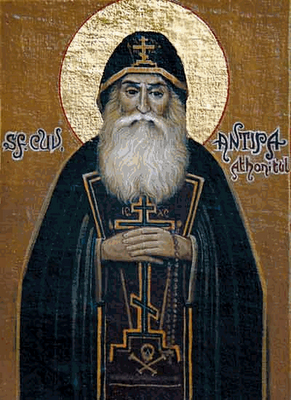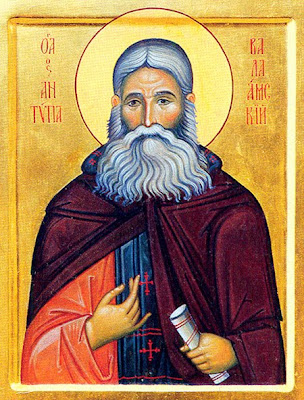 |
| St. Antipas of Athonite (Feast Day - January 10) |
Saint Antipas was born in 1816 in the little village of Calapodesti in Moldavia. He decided to embrace the monastic life at the age of twenty after a vision of the divine light. Although hard-pressed by the demons he kept to his resolve, which was confirmed by a miracle before the icon of the Mother of God at the Monastery of Neamts. He was received as a novice at the little monastery of Calderusani in Wallachia, and he worked there in complete renunciation of his own will. Having no cell of his own, he would snatch a little sleep on completing his work in the kitchen or on the farm. The hermit Gideon, who had been living as a recluse near the Monastery for thirty years, taught him the practice of inner prayer, and such was his zeal for it that his confessor advised him to leave for Mount Athos after two years.
On reaching the Holy Mountain, the young novice asked two Moldavian hieromonks at the skete of Lakkou to accept him as a disciple. But Father Niphon and Father Nectarius advised him to spend a while in a cenobitic monastery, before entering upon the contests of the desert, and so he made his way to the Monastery of Esphigmenou where he spent four years working in the kitchen. So harshly was he tried there by acedia and dryness in prayer that, with his spirit and heart full of darkness and distress, only his unshakable faith in the Mother of God saved him from despair.
At the conclusion of his novitiate, he was accepted by the two elders, who tonsured him a monk with the name Antipas. Father Niphon opposed his desire to lead the hesychastic life, for he counted on Antipas' help in the foundation he was planning of an independent Romanian monastery on Athos. However, having a confessor in common, Antipas was able with his support to leave for the desert, even though his Elder refused him the essentials for living, so that he settled utterly destitute in a ruined hermitage. An old icon of the Mother of God blackened by time, which he found there, was miraculously renewed and became ever after the consolation and the joy of the valiant desert warrior.
Time passed and Father Niphon's plan took shape. He managed to acquire some land on Athos and he founded a metochion (dependency) in the Moldavian city of Iasi, intended to provide the resources needed for his foundation. Having persuaded Antipas to take part in his project, he appointed him cellarer of his growing Athonite community, and he put him in charge of the building-works as his deputy for the duration of his own three-year absence from the Holy Mountain. On his return, Father Niphon sent Antipas to Iasi as steward of the metochion. Thrown despite himself into the tumult of the city, Saint Antipas made no compromises in his manner of life but, increasing his fasts and vigils to the uttermost in order to arm himself against temptations, he grew day by day in friendship with God. Notwithstanding his desire to stay hidden, many of the faithful in search of spiritual direction were drawn to him. The Metropolitan of Moldavia often came to talk with him, and he appointed him confessor of two monasteries of women. His presence at the metochion assured it of great influence and attracted support in abundance for the Athonite monastery; but these advantages could never outweigh his desire to live in the desert. But far from responding to his repeated pleas, Father Niphon suggested that he accompany him to Russia in order to collect funds. Foregoing his own will once again, he went to Russia with his elder. But after a short time Father Niphon returned to Moldavia, leaving him alone in a country whose language he did not know. He settled as a recluse on the estate of some pious merchants and left his cell only when obliged by a particular invitation. Despite this retreat, gifts of all kinds flowed in for the Romanian skete. When they amounted to more than 30,000 rubles - besides bells and other valuables - he sent them by ship to Mount Athos, but the vessel with all her passengers and her entire cargo went down in a storm. Father Antipas did not lose courage at this catastrophe but continued his mission in St. Petersburg. Attracted by his wisdom and spiritual influence, many of the faithful came to him for his words of edification, and they left him gifts for the Romanian skete, so that before long he was able to send a large sum to Mount Athos.
One day during Lent, when he was staying at the St. Alexander Nevsky Lavra in Moscow, the monk who shared his cell was amazed that, after following the round of services in the church, he would retire to his cell in order to celebrate them again in Romanian, as well as to fulfill all the rules of prayer of monks of the Great Habit, so that he remained in prayer day and night without eating or drinking anything.
In 1865, having completed his mission on behalf of the Romanian skete, he went to the Monastery of Valaam, the Athos of the North, and withdrew to a small isolated cell belonging to the Skete of All Saints, in order to pursue his contests in perfect hesychia. Besides the services prescribed by the Typikon, he recited two akathists to the Mother of God, made more than 300 great prostrations and spent over an hour commemorating the names of all his benefactors. Apart from these intervals of liturgical prayer, he spent almost all the rest of his time at inner prayer. Driving away every thought and every distraction from his heart, his prayer rose towards God without cease as an acceptable sacrifice for the salvation of the whole world. He went to the main Monastery only three times a year and, making himself "all things to all men" (1 Cor. 9:22), he freely gave of himself in spiritual conversations with pilgrims who had come from afar to meet him. By his teaching he guided many monks and lay people from the North of Russia and from Finland, even though he was the only Romanian monk living in those distant regions. Freed of all attachment to this world, his deep humility and readiness to blame himself enabled him to bear adversities of all kinds with equanimity, as well as the opposition that his renown sometimes provoked.
He had a strong constitution and was rarely ill, despite the exceeding severity of his way of life. But one day he caught a chill and his health gradually declined, leading him peacefully in the course of a year from his desert refuge to the heavenly mansions.
During his last winter, while he was at prayer in his cell, the miraculous icon of the holy Mother of God, which he had brought from Athos as his sole treasure, moved of its own accord and stopped for veneration at a height level with his chin. Three days later, the holy ascetic fell asleep in peace on 10 January 1882.
Notes:
* An English translation of his Life has been published in Orthodox Word No. 196 (1997), pp. 232-53. He is the only one of the Romanian monks who have lived on Mount Athos to be canonized by the Romanian Church (1906). His veneration was recognized by the Russian Church after the uncovering of his relics in 1991.
From The Synaxarion: The Lives of the Saints of the Orthodox Church (Vol. 3) by Hieromonk Makarios of Simonos Petra.
For more in English, see here.


